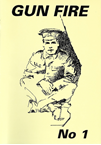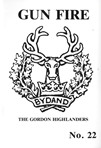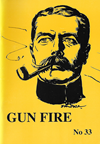Gun Fire 'Notes and Queries'. Some examples
- Home
- World War I Articles
- Gun Fire 'Notes and Queries'. Some examples
For the entire 59 editions of Gun Fire the editor, Alf Peacock, ran (with the exception of one or two of the special editions) a 'Notes and Queries' section. Quite often the points he made were criticisms of errors he noticed or brief vignettes that caught his attention. Of course it is now possible via the internet to quickly establish some of the background to these stories Alf unearthed. However, many of the Notes and Queries do still shine a light on unusual matters which remain interesting.
All of these magazines are now available to WFA members via the Member Login.
Joining The Western Front Association gives you access not only to the 59 editions of Gun Fire but also to all 110+ issues of the WFA's in house journal Stand To!
In the first edition of Gun Fire, Alf Peacock started the 'Notes and Queries' with the following sentence, and kicked off with N&Q number 1 about the Military Medal. These Notes and Queries were sequentially numbered and eventually ran to well over 1,000, in the web article below we take a random sample of some of these...All of the following are extracts from the editions of Gun Fire.
Gun Fire 1

Readers might like to send us items of interest and/or notes of errors or misinterpretations in published works which could mislead others. Along the lines of the following.
1) The Military Medal
Some novelists are meticulous in their research - others drop quite inexplicable clangers. D. Jack, That's Me in the Middle (1974) describes a character who had transferred from the army to the RFC. He had been awarded the Military Medal. He got it at Mons, where he was captured; a character announced. The MM was not instituted until March 1916.
A. James
Gun Fire 7

113) The First?
Gun Fire has contained notes about the oldest soldier of the Great War ·and the youngest. "There - is some difficulty 'in interpreting the terms used in the following case, but in mid September 1914 the national press announced details about the first volunteer of the war to be killed in action. This was Julian Martin Smith who was wounded on 7 September and died two days later. Smith was described as being 'of· the Intelligence Department of the Expeditionary Force'. He was the son of Martin Smith, a partner in the firm of Rowe and Pitman, and had been educated at Eton and Trinity College, Cambridge. He had joined the Stock Exchange in 1909, and had been attached to the 9th Lancers as an interpreter."
The information above came from The Times, but the Eton School Register Part VII, 1899-1909, refers to what must be the same person as Julian Horace Smith, fourth son of M.R. Smith of Hayes, and says he served as a 2nd Lt with the Mounted Intelligence Corps. attached to the 9th Lancers. It gives a different date for Smith's death, saying he died on 8 September 'of wounds received in action at Nangis.'
The records of Trinity College nicely solve the question of Smith's name, giving .it as Julian Horace Martin. Dr Timothy Hcbbs, the College's Sub-Librarian, said that the Admissions Book records his place and date of birth as Hayes, 2 November 1887 and his father's name as Martin Ridley Smith. Julian matriculated on 1 October 1906·, but does not seem to have passed any Tripos, and the College's Service List contains the only other record it has of him. It gives a third date for his death, and reads: 'SMITH; J.H. MARTIN. 2nd Lieut., Spec. List (Intelligence) Died 10 September 1914.
AJ Peacock
Gun Fire 22

337) The Hull Pals
B.S. Barnes' work This Righteous War, the story of the Hull Pals, has been severely criticised in Gun Fire and P.T. Scott's The Great War and, for all I know, other journals. Perhaps the tone of the book was set by the introduction by Mr John Prescott MP. In an emotional little piece not entirely devoid of spelling mistakes ('unparalelled'), Mr Prescott writes (my italics) of 'Senior officers well behind the enemy lines, [who] seldom felt the conditions of horror, or the bitter consequences of their orders ... ' Really?
P. Butcher, Sale
Gun Fire 24

387) Captain Henderson
The standard guides to the battlefields all refer to Raymond Asquith's grave at Guillemont, but he is not the only son of an eminent cabinet minister to be buried on the Somme. There is a second: his name 1s Captain David Henderson, of the 3/8 Middlesex Regiment, 4 7th (London) Division. He died in the attack on High Wood on 15 September 1916 and is buried in the London Cemetery, High Wood, Longueval, France. His headstone is inscribed 'Peace was the prize of all his toil and care.' The Guillemont cemetery register lists Capt Henderson 's father as Arthur Henderson, PC, MP., an important figure in the early days of the Labour party and a prominent and influential trade union leader. Following Ramsay MacDonald's refusal to endorse the pro-war stance of the Parliamentary Labour party, Henderson led it from 1914-1922. He again succeeded Ramsay MacDonald as leader from 1931-32. Arthur Henderson had three sons, David, Arthur and Will; and all three were in the fighting line in the First World War. David was the eldest and according to his brothers he was the most gifted of the family and the one most like his father.
Hedley Malloch, Guisborough
401) German Pill Box, British Cement .
Many readers will have heard of the contentions that many German pill boxes were built with British cement. They might be interested to know that they gained ground and momentum when the following letter appeared in the Times of 19 November 1917. Sir - Having just read the protest of the members of the Baltic Shipping Exchange against the shipment of cement to Holland, I have no doubt it will interest them and others to know that the pillbox in which I now write and which was built by the enemy is made of British cement This I know by a small tin label which was dislodged from the middle of a thick wall by a shell; the label was embossed in English.
R.P. Hewetson, Capt.
Gun Fire 33

617) PARKHURST MEMORIAL
The following extract about a 1914-18 memorial (which has been noted in these columns before) appeared in a newspaper published in the 1920s. (1) Gun Fire has carried mentions of a VC winner who would seem to fit the description in the article.
HONOURING CONVICT HEROES
MEMORABLE CEREMONY AT PARKHURST PRISON
Perhaps the most unique and interesting war memorial in the country is that placed in the Prison Chapel at Parkhurst, which was unveiled on Wednesday by Major-General J.E.B. Seely, C.B., C.M.G., D.S.O., M.P., the lord-lieutenant of Hampshire, for it is a tribute paid by convicts to fellow prisoners who were liberated on volunteering to fight for their country and fell gallantly facing the enemy. The memorial consists of a brass tablet on a dark oak background, and the inscription is:
To the glory of God and in memory of those who went from imprisonment in this place and gave their lives on the Field of Honour in the Great War, 1914-1918. "These are they which came out of tribulation." Rev. vii. 14. Erected by their fellow prisoners.
The memorial was subscribed for by the convicts only, and so keen were some to give substantial sums towards it that the Governor had to limit the subscriptions. Men of all nationalities, including a German and a Mahommedan, willingly gave their little quota, and judging by the reverence and general demeanour of the 700 or so prisoners who were present at the unveiling ceremony, no memorial yet erected has been raised with a more genuine spirit of respect and honour than was this tablet in memory of men who might, not unjustly perhaps, have felt that they had but little to arouse their spirit of patriotism. Yet, as the Governor and the gallant General mentioned in the course of their sympathetic and able speeches, almost every man who was able volunteered, and amongst the large number who went was one brave man who died of wounds after winning the highest honour the British nation can award her heroes of the battlefield - the V.C., whilst several others gained commissions and promotion for gallantry.
... An official return issued on Thursday gives the total number of ex-convicts who gave their lives in the war as 283. (2) The winner of the V.C. was a Salford (Lancashire) man who served in the 2nd Battalion King's Royal Rifles. Two others won the D.C.M., three the M.M., and one the Russian Order of St George. (3)
Ken Tyrell, Isle of Wight
- Isle of Wight County Press, 1 April 1921. The quote is from Mr Tyrell's transcript
- This number, I assume, refers to the entire prison population and not just those men freed from Parkhurst. The newspaper article does not contain a figure which can be associated with Parkhurst
- The editor wrote to the governor of Parkhurst asking for details of the memorial and, if possible, a photograph. No reply of any kind has been received.
Gun Fire 59

1032) THE LAST CAVALRY CHARGE
Another contribution to Gun Fire's catalogue of firsts, oldests, and things like that. What about this incident? It happened in Abyssinia in January 1941. Gazette Force was the HQ of the British force 'tasked' to attack the Italians. It was equipped with armoured cars, tanks and howitzers and was stationed on the Sudanese border when they were subjected to the last full cavalry charge in military history 'led by an Italian officer on a magnificent white horse.' He was Amedeo Guillet and his charge created 'considerable panic.' He was an extraordinary man whose story is told in S O'Kelly, Amadeo: A True Story of Love and War in Abyssinia.
T. Johnson, Leeds
FURTHER READING:
Gun Fire: the re-publication of a renowned WFA journal





